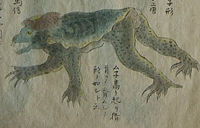Kappa (folklore)
| Kappa | |
|---|---|
 |
|
| A drawing of a kappa. | |
| Creature | |
| Name: | Kappa |
| AKA: | Gatarō, Kawako |
| Classification | |
| Grouping: | Legendary creature |
| Sub grouping: | Sprite |
| Data | |
| Mythology: | Japanese mythology |
| Country: | Japan |
| Habitat: | Water |
| Status: | Unconfirmed |
Kappa (河童? "river-child"), alternately called Kawatarō (川太郎? "river-boy") or Kawako (川子? "river-child") , are legendary creatures; a type of water sprite found in Japanese folklore. However they are also considered to be a part of cryptozoology, due to claims of sightings. In Shintō they are considered to be one of many suijin (literally "water-deity").
Contents |
Appearance
Most depictions show kappa as child-sized humanoids, though their bodies are often more like those of monkeys or frogs than human beings. Some descriptions say their faces are apelike, while others show them with beaked visages more like those of tortoises or with duck beaks. Pictures usually show kappa with thick shells and scaly skin that ranges in color from green to yellow or blue.
Kappa supposedly inhabit the ponds and rivers of Japan and have various features to aid them in this environment, such as webbed hands and feet. They are sometimes even said to smell like fish, and they can certainly swim like them. The expression kappa-no-kawa-nagare ("a kappa drowning in a river") conveys the idea that even experts make mistakes.
The most notable feature of the kappa, however, is the water-filled depressions atop their heads. These cavities are surrounded by scraggly hair, and this type of bobbed hair style is named okappa-atama for the creatures. The kappa derive their incredible strength from these liquid-filled holes, and anyone confronted with one may exploit this weakness by simply getting the kappa to spill the water from its head. The kappa possesses a deep sense of etiquette, so one trusted method is to appeal to this, for a kappa cannot help but return a deep bow, even if it means losing its head-water in the process. Once depleted, the kappa is seriously weakened and may even die. Other tales say that this water allows kappa to move about on land, and once emptied, the creatures are immobilized. Stubborn children are encouraged to follow the custom of bowing on the grounds that it is a defense against kappa. In addition, folklore suggests that kappa are masters of Koppo, a bone-breaking technique which they invented.
Behavior

Kappa are usually seen as mischievous troublemakers. Their pranks range from the relatively innocent, such as loudly passing gas or looking up women's kimonos, to the more troublesome, such as stealing crops, kidnapping children. In fact, small children are one of the gluttonous kappa's favorite meals, though they will eat adults as well. They feed on these hapless victims by sucking out the shirikodama (尻子玉?)[1] (or entrails, blood, liver, or "life force", depending on the legend) through the anus. Even today, signs warning about kappa appear by bodies of water in some Japanese towns and villages. Kappa are also said to be afraid of fire, and some villages hold fireworks festivals each year to scare the spirits away.
Kappa are not entirely antagonistic to mankind, however. They are curious of human civilization, and they can understand and speak Japanese. They thus sometimes challenge those they encounter to various tests of skill, such as shogi or sumo wrestling. They may even befriend human beings in exchange for gifts and offerings, especially cucumbers, the only food kappa are known to enjoy more than human children. Japanese parents sometimes write the names of their children (or themselves) on cucumbers and toss them into kappa-infested waters in order to mollify the creatures and allow the family to bathe. There is even a kind of cucumber-filled sushi roll named for the kappa, the kappamaki.
Once befriended, kappa have been known to perform any number of tasks for human beings, such as helping farmers irrigate their land. They are also highly knowledgeable of medicine, and legend states that they taught the art of bone setting to mankind. Due to these benevolent aspects, some shrines are dedicated to the worship of particularly helpful kappa. Kappa may also be tricked into helping people. Their deep sense of decorum will not allow them to break an oath, for example, so if a human being can dupe a kappa into promising to help him, the kappa has no choice but to follow through.
See also
- Kappabashi-dori, a neighborhood in Tokyo. Kappa here is a homophone, but the homophony is exploited.
- Summer Days with Coo 2007 Anime
External links
- Mark Schumacher (2004). Kappa -- River Imp or Sprite. Retrieved March 23, 2006.
- Garth Haslam (2000). Kappa Quest 2000. Retrieved December 14, 2006.
- Kirainet (2007). For a look at Kappa in popular culture Kirainet. Retrieved May 6, 2007.
 |
Japanese mythology and folklore |
|---|---|
|
Mythic texts and folktales: |
|
| Religions | Sacred objects | Creatures and spirits |
|
|||||||||||||||||||||||||||||||||||||||||||||||||||